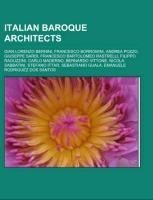
-
 Anglický jazyk
Anglický jazyk
Italian Baroque architects
Autor: Source: Wikipedia
Source: Wikipedia. Pages: 28. Chapters: Gian Lorenzo Bernini, Francesco Borromini, Andrea Pozzo, Giuseppe Sardi, Francesco Bartolomeo Rastrelli, Filippo Raguzzini, Carlo Maderno, Bernardo Vittone, Nicola Sabbatini, Stefano Ittar, Sebastiano Guala, Emanuele... Viac o knihe
Na objednávku
12.94 €
bežná cena: 14.70 €
O knihe
Source: Wikipedia. Pages: 28. Chapters: Gian Lorenzo Bernini, Francesco Borromini, Andrea Pozzo, Giuseppe Sardi, Francesco Bartolomeo Rastrelli, Filippo Raguzzini, Carlo Maderno, Bernardo Vittone, Nicola Sabbatini, Stefano Ittar, Sebastiano Guala, Emanuele Rodriguez Dos Santos, Carlo Lurago, Mattia de Rossi, Pietro Perti, Giovanni de Galliano Pieroni, Gherardo Silvani, Francesco Maria Richini, Martino Longhi the Younger, Adriano Cristofali, Giovanni Battista Gisleni, Carlo Rainaldi, Giacomo Zanetti, Giuseppe Arighini, Fabio Mangone, Giovan Battista Aleotti, Giovan Antonio de' Rossi, Giovanni Bassignani, Giorgio Massari, Agostino Barelli, Lorenzo Binago, Giuseppe Benoni, Bartolomeo Bianco, Giovanni Magenta. Excerpt: Gian Lorenzo Bernini (also spelled Gianlorenzo or Giovanni Lorenzo) (Naples, 7 December 1598 - Rome, 28 November 1680) was an Italian artist who worked principally in Rome. He was the leading sculptor of his age and also a prominent architect. In addition he painted, wrote plays, and designed metalwork and stage sets. A student of Classical sculpture, Bernini possessed the unique ability to capture, in marble, the essence of a narrative moment with a dramatic naturalistic realism which was almost shocking. This ensured that he effectively became the successor of Michelangelo, far outshining other sculptors of his generation, including his rival, Alessandro Algardi. His talent extended beyond the confines of his sculpture to consideration of the setting in which it would be situated; his ability to be able to synthesise sculpture, painting and architecture into a coherent conceptual and visual whole has been termed by the art historian, Irving Lavin, the 'unity of the visual arts'. A deeply religious man, working in Counter Reformation Rome, Bernini used light as an important metaphorical device in the perception of his religious settings; often it was hidden light sources that could intensify the focus of religious worship, or enhance the dramatic moment of a sculptural narrative. Bernini was also a leading figure in the emergence of Roman Baroque architecture along with his contemporaries, the architect, Francesco Borromini and the painter and architect, Pietro da Cortona. Early in their careers they had all worked at the same time at the Palazzo Barberini, initially under Carlo Maderno and on his death, under Bernini. Later on, however, they were in competition for commissions and fierce rivalries developed, particularly between Bernini and Borromini. Despite the arguably greater architectural inventiveness of Borromini and Cortona, Bernini's artistic pre-eminence, particularly during the reigns of popes Urban VIII (1623-44) and Alexander VII (1655-1665), meant he
- Vydavateľstvo: Books LLC, Reference Series
- Rok vydania: 2011
- Formát: Paperback
- Rozmer: 246 x 189 mm
- Jazyk: Anglický jazyk
- ISBN: 9781155534770





 Nemecký jazyk
Nemecký jazyk 





